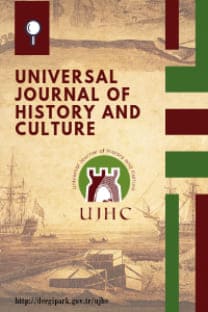Molla Mustafa Başeski Tarafından Kaleme Alınan Mecmûa'da Öteki Hakkında Algıların Dünya Görüşü Açısından Temelleri
Makalede, postyapısalcı imgebilim izinde, 18. yüzyılın ikinci yarısında Osmanlı Türkçesi ile yazılmış Molla Mustafa Başeski’nin Mecmûa’sında hetero algıların dünya görüşü açısından temelleri ele alınmaktadır. Son kültürel araştırma yöntemlerini uygulayarak ve ötekinin imajının her zaman kültürel olarak koşullandırıldığı varsayımından yola çıkarak, bu inceleme diğer din mensuplarına (Bosnalı Katolikler, Ortodoks ve Yahudiler), Osmanlı İmparatorluğu'nun askerî ve siyasi düşmanlarına (Avusturyalılar, Ruslar, Karadağlılar) ve Bosnalı olmayanlara (Türkler ve Araplar) odaklanmaktadır. Araştırmanın amacı, yazısı gizli olduğu için iktidara karşı boyun eğmeye mecbur olmayan güvenli bir şahit ve tahlilcinin dünya görüşünü kullanarak geç Osmanlı dönemdeki Bosna çokkültürlülük modelinin tabiatını aydınlatmaktır. Mecmûa yazarının diğer din mensuplarının imajını oluşturma şekli, her zaman komşu olmalarına, yaşam alanlarının paylaşıldığı veya İmparatorluğun diğer tarafındaki kâfir olmalarına bağlıdır. Başeski'nin "iç ötekilerin" tanımlamaları, karakterizasyonu ve yorumları asla söz konusu kişinin öncelikle din kimliğine yönelmez; ister olumlu ister olumsuz olsun, bu karakterizasyonlar her zaman ad hominem yönelimli, somut insanlara bağlıdır ve gösterilen özellikler, imagolojik anlamda, din üstü, genel ve evrenseldir. Böyle bir algı, muhtemelen kronikçinin İslam'ın orijinal ilkelerinin kozmopolit yorumlanması ve tasavvufa duyduğu sempatisi ile ilişkilidir. Bu nedenle, Mecmûa’daki Saraybosna'nın imagolojik ufku, laik-tanımlayıcı düzeyde değil, deneyimsel, somut ve metafizik olguları bağdaştıran etik düzeyde işlev görür. “Dış ötekiler” söz konusu olduğunda, bilgi eksikliği ve gerçek tehdide karşı duygusal tutum, Başeski’de de bu algı çizgisinde mitolojik önyargılar ve klişe yargıların hâkim olmasını sağlamıştır.
Anahtar Kelimeler:
Molla Mustafa Başeski, Mecmûa, Postyapısalcı İmgebilim, Hetero Algılar
The Image of the Other in Mulla Mustafa Basheski`s Chronicle on the Basis of His Worldview
Written in the second half of the 18th century in the Ottoman Turkish language the Chronicle of Mulla Mustafa Basheski discusses ideological references about hetero-images in regard to post-structuralist imagology. Considering the hypothesis that the image of the other is always culturally conditioned, the members of other religions are researched through the analysis (Bosnian Catholics, Orthodox, and Jews), military and political enemies of the Ottoman Empire (Austrians, Russians, Montenegrins) and non-Bosnians (Turks and Arabs). To be more precise, the way in which the chronicler creates the image of the members of other religions always depends on the fact whether they are neighbors i.e. people who live nearby and share living space or the members of other religions living across the Empire’s border. Basheski's descriptions, characterizations, as well as his comments of the ''inner others'', are never primarily directed at the religious identity of the mentioned ones; those characterizations, however, either affirmative or negative, are always ad hominem oriented and related to real people. Nevertheless, as regards to the imagery point of view, those characterizations go beyond the notion of religion, being general and universal. Accordingly, such perception is related to the chronicler's cosmopolitan interpretation of the original rules of Islam, as well as to his affinity towards Sufi mysticism. As a result, the imagery point of view of Sarajevo in the Chronicle does not function on the profane-descriptive, but on the ethical grounds, thus connecting empirical, concrete, and metaphysical. However, as regards to the ''external others'', the lack of information and affective relation towards the real danger, resulted in the predominance of mythological conceptions and stereotypes even in Basheski's Chronicle.
___
- Ahmed, A. (2019). Putovanje u Evropu. Sarajevo: El-Kalem.
- Arkoun, M. (1996). Ljudska prava u kontekstu islamsko-zapadne debate. In E. Karic (Ed.), Ljudska prava i islam (p. 159-170). Sarajevo: Fond otovreno drustvo.
- Baseskija, M. M. (1997). Ljetopis. Sarajevo: Sarajevo Publishing.
- Dzaja, S. M. (1992). Konfesionalnost i nacionalnost Bosne i Hercegovine. Sarajevo: Svjetlost.
- Durakovic, E. P. (2004). Kur’an-ı Kerim. Sarajevo: Svjetlost.
- Filan, K. (2014). Sarajevo u Baseskijino doba: Jezik kao stvarnost. Sarajevo: Connectum.
- Gvozden, V. (2005). Knjizevna imagologija u perspektivi. Ostrvo(4), 3-21.
- Karahasan, D. (2004). Knjiga vrtova. Sarajevo: Connectum.
- Karic, E. (1982a). Humanisticki nazori Mula Mustafe Baseskije. Glasnik Vrhovnog islamskog starjesinstva u SFRJ, 3, 329-335.
- Karic, E. (1982b). Ljetopisac Mula Mustafa Baseskija. Glasnik Vrhovnog islamskog starjesinstva u SFRJ, 2, 195-206.
- Lovrenovic, I. (1989). Labirint i pamcenje. Sarajevo: Oslobodenje.
- Malcolm, N. (1995). Povijest Bosne. Sarajevo: Dani: Erasmus Gilda - Novi Liber.
- Mehmed Meyli Gurani b. İsmail Bosnevi . (1746-1804). Mula Mustafa Baseskija. Sarajevo: Mecmu’a, Gazi Husrev-begova biblioteka. (kayıt no. 7340)
- Nasr, S. H. (1996). Religija i religije: İzazov zivljenja u mutireligijskom svijetu. In E. Karic (Ed.), In Ljudska prava u kontekstu islamsko-zapadne debate (p. 11-41). Sarajevo: Fond otvoreno drustvo.
- Schimmel, A. (2004). İslamın mistik boyutları. İstanbul: Kabalcı.
- Spahic, V. (2018). Anticipativna poetika tajnog spisa: O knjizevnim vrednotama i novovjekovnoj etici Baseskijina nekrologija. Drüstvene i humanisticke studije - DHS 1, 4, 189-194.
- Zgodic, E. (1998). Bosnjacko iskustvo politike. Sarajevo: Euromedija.
- ISSN: 2667-8179
- Başlangıç: 2019
- Yayıncı: Orhan TURAN
